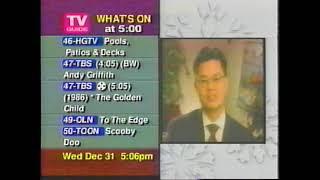
December 31 1997 TV Guide
TV Guide is an American digital media company that provides television program listings information as well as entertainment and television-related news.
The company sold its print magazine division, TV Guide Magazine LLC, in 2008.
The prototype of what would become TV Guide Magazine was developed by Lee Wagner (1910–1993), who was the circulation director of MacFadden Publications in New York City in the 1930s – and later, by the time of the predecessor publication's creation, for Cowles Media Company – distributing magazines focusing on movie celebrities.
In 1948, Wagner printed New York City area listings magazine The TeleVision Guide, which was first released on local newsstands on June 14 of that year. Silent film star Gloria Swanson, who then starred of the short-lived variety series The Gloria Swanson Hour, appeared on the cover of the first issue. Wagner later began publishing regional editions of The TeleVision Guide for New England and the Baltimore–Washington area. Five years later, he sold the editions to Walter Annenberg, who folded it into his publishing and broadcasting company Triangle Publications, but remained as a consultant for the magazine until 1963.
The national TV Guide's first issue was released on April 3, 1953, accumulating a total circulation of 1,560,000 copies that were sold in the ten U.S. cities where it was distributed. The inaugural cover featured a photograph of Lucille Ball's newborn son Desi Arnaz Jr., with a downscaled inset photo of Ball placed in the top corner under the issue's headline: "Lucy's $50,000,000 baby". The magazine was published in digest size, which remained its printed format for 52 years. From its first issue until the July 2–8, 1954, issue, listings within each edition of TV Guide began on Friday and ended on Thursday; the July 9–16, 1954, issue began on a Friday and ended on the following Friday. Then, beginning with the July 17–23, 1954, issue, the listings in each week's issue changed to start on Saturday and end on Friday, which remained the listings format for all local editions until April 2004.[citation needed] The formation of TV Guide as a national publication resulted from Triangle Publications' purchase of numerous regional television listing publications such as TV Forecast (which was circulated in the Chicago area and, upon its first publication on May 9, 1948, was the first continuously published television listings magazine), TV Digest (which was distributed in Philadelphia and Pittsburgh, and was originally distributed under the title, the Local Televiser, when it was first released on November 7, 1948), and the New York-based Television Guide (which had its title abbreviated to TV Guide on March 18, 1950). Each of the cities that had their own local TV listings magazine folded into TV Guide were among the initial cities where the magazine conducted its national launch.
The launch as a national magazine with local listings in April 1953 became an almost instant success.However, the circulation decreased over subsequent weeks, even as the magazine's distribution expanded to five additional cities (Pittsburgh, Rochester, Detroit, Cleveland and San Francisco) throughout the summer of 1953. By mid-August of that year, sales of the magazine had dropped 200,000 copies below that of the first issue. TV Guide's fortunes began to turn around with the September 4–10, 1953, issue – the magazine's first "Fall Preview" issue – when circulation hit 1,746,327 copies; circulation levels increased steadily over time, to the point where TV Guide eventually became the most read and circulated magazine in the United States by the 1960s.The initial cost of each issue was 15¢ per copy (equivalent to $1.64 in 2022. The price per issue has gradually risen over the years, selling for $4.99 per copy as of 2023). In addition to subscriptions, TV Guide was sold at the checkout counters of grocery stores nationwide. Until the 1980s, the feature pieces included in each issue were promoted in a television commercial. Under Triangle, TV Guide continued to grow not only in circulation, but also in recognition as the authority on television programming with articles – the majority of which typically appear in the color section – from both staff and contributing writers.
Over the decades, the shape of the TV Guide logo has changed to reflect the modernization of the television screen, eventually adopting a widescreen appearance in September 2003, and then to its current flatscreen appearance in September 2016 (different versions of the logo – the only cosmetic difference being the utilization of different typefaces – are currently used respectively for the magazine and the separately owned, CBS-managed digital properties). At first, the logo had various colored backgrounds (usually black, white, blue or green) until the familiar red background became the standard in the 1960s with occasional customizations being utilized for special editions.
#tvguide #tvlistings
The company sold its print magazine division, TV Guide Magazine LLC, in 2008.
The prototype of what would become TV Guide Magazine was developed by Lee Wagner (1910–1993), who was the circulation director of MacFadden Publications in New York City in the 1930s – and later, by the time of the predecessor publication's creation, for Cowles Media Company – distributing magazines focusing on movie celebrities.
In 1948, Wagner printed New York City area listings magazine The TeleVision Guide, which was first released on local newsstands on June 14 of that year. Silent film star Gloria Swanson, who then starred of the short-lived variety series The Gloria Swanson Hour, appeared on the cover of the first issue. Wagner later began publishing regional editions of The TeleVision Guide for New England and the Baltimore–Washington area. Five years later, he sold the editions to Walter Annenberg, who folded it into his publishing and broadcasting company Triangle Publications, but remained as a consultant for the magazine until 1963.
The national TV Guide's first issue was released on April 3, 1953, accumulating a total circulation of 1,560,000 copies that were sold in the ten U.S. cities where it was distributed. The inaugural cover featured a photograph of Lucille Ball's newborn son Desi Arnaz Jr., with a downscaled inset photo of Ball placed in the top corner under the issue's headline: "Lucy's $50,000,000 baby". The magazine was published in digest size, which remained its printed format for 52 years. From its first issue until the July 2–8, 1954, issue, listings within each edition of TV Guide began on Friday and ended on Thursday; the July 9–16, 1954, issue began on a Friday and ended on the following Friday. Then, beginning with the July 17–23, 1954, issue, the listings in each week's issue changed to start on Saturday and end on Friday, which remained the listings format for all local editions until April 2004.[citation needed] The formation of TV Guide as a national publication resulted from Triangle Publications' purchase of numerous regional television listing publications such as TV Forecast (which was circulated in the Chicago area and, upon its first publication on May 9, 1948, was the first continuously published television listings magazine), TV Digest (which was distributed in Philadelphia and Pittsburgh, and was originally distributed under the title, the Local Televiser, when it was first released on November 7, 1948), and the New York-based Television Guide (which had its title abbreviated to TV Guide on March 18, 1950). Each of the cities that had their own local TV listings magazine folded into TV Guide were among the initial cities where the magazine conducted its national launch.
The launch as a national magazine with local listings in April 1953 became an almost instant success.However, the circulation decreased over subsequent weeks, even as the magazine's distribution expanded to five additional cities (Pittsburgh, Rochester, Detroit, Cleveland and San Francisco) throughout the summer of 1953. By mid-August of that year, sales of the magazine had dropped 200,000 copies below that of the first issue. TV Guide's fortunes began to turn around with the September 4–10, 1953, issue – the magazine's first "Fall Preview" issue – when circulation hit 1,746,327 copies; circulation levels increased steadily over time, to the point where TV Guide eventually became the most read and circulated magazine in the United States by the 1960s.The initial cost of each issue was 15¢ per copy (equivalent to $1.64 in 2022. The price per issue has gradually risen over the years, selling for $4.99 per copy as of 2023). In addition to subscriptions, TV Guide was sold at the checkout counters of grocery stores nationwide. Until the 1980s, the feature pieces included in each issue were promoted in a television commercial. Under Triangle, TV Guide continued to grow not only in circulation, but also in recognition as the authority on television programming with articles – the majority of which typically appear in the color section – from both staff and contributing writers.
Over the decades, the shape of the TV Guide logo has changed to reflect the modernization of the television screen, eventually adopting a widescreen appearance in September 2003, and then to its current flatscreen appearance in September 2016 (different versions of the logo – the only cosmetic difference being the utilization of different typefaces – are currently used respectively for the magazine and the separately owned, CBS-managed digital properties). At first, the logo had various colored backgrounds (usually black, white, blue or green) until the familiar red background became the standard in the 1960s with occasional customizations being utilized for special editions.
#tvguide #tvlistings
Тэги:
##tvguide ##tvlistings #tv #telivision #tvlistings #listings #whatson #decembeer31 #newyearseveКомментарии:
December 31 1997 TV Guide
Step Daddy J
Mounts Bay Modernists: MBM and Friends - King Harry Ferry
Mounts Bay Modernists
Кино-Домино
Кино Домино
3 Radiant Sheriffs VS 7 Gold Vandals!
Valorant Curios


























